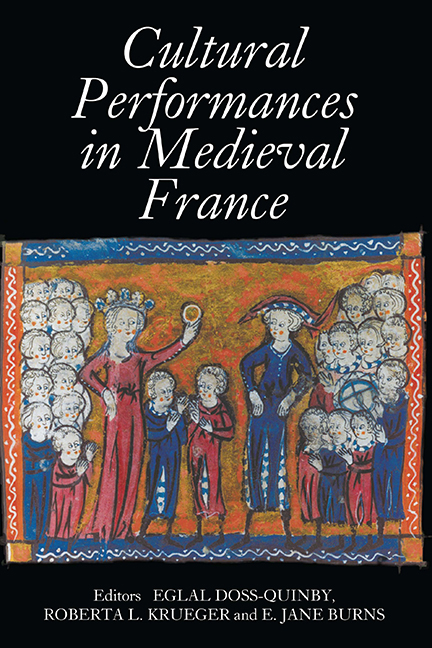Book contents
- Frontmatter
- Contents
- List of Illustrations
- Contributors
- Introduction
- Nancy Freeman Regalado, Curriculum Vitae
- PART I POETIC AND MUSICAL PERFORMANCES
- PART II PERFORMING SEXUAL AND SOCIAL IDENTITIES
- PART III DEVOTIONAL PRACTICE AND TEXTUAL PERFORMANCE
- PART IV PERSUASIVE PERFORMANCES
- PART V RE–ENACTMENTS AND LEGACIES
- Variegated Performance of Aucassin et Nicolette
- Late Medieval Representations of Storytelling and Story-Performance
- Paratextual Performances in the Early Parisian Book Trade: Antoine Vérard's Edition of Boccaccio's Nobles et cleres dames (1493)
- “Resuscitating” Medieval Literature in New York and Paris: La femme que Nostre-Dame garda d'estre arse at Yvette Guilbert's School of Theatre, 1919–24
- The Pitfalls and Promise of Classroom Performance
- ” Dunc chante haut et cler » : remarques sur l'interprétation de la musique médiévale
- Tabula Gratulatoria
- Tabula Gratulatoria
“Resuscitating” Medieval Literature in New York and Paris: La femme que Nostre-Dame garda d'estre arse at Yvette Guilbert's School of Theatre, 1919–24
from PART V - RE–ENACTMENTS AND LEGACIES
Published online by Cambridge University Press: 24 October 2017
- Frontmatter
- Contents
- List of Illustrations
- Contributors
- Introduction
- Nancy Freeman Regalado, Curriculum Vitae
- PART I POETIC AND MUSICAL PERFORMANCES
- PART II PERFORMING SEXUAL AND SOCIAL IDENTITIES
- PART III DEVOTIONAL PRACTICE AND TEXTUAL PERFORMANCE
- PART IV PERSUASIVE PERFORMANCES
- PART V RE–ENACTMENTS AND LEGACIES
- Variegated Performance of Aucassin et Nicolette
- Late Medieval Representations of Storytelling and Story-Performance
- Paratextual Performances in the Early Parisian Book Trade: Antoine Vérard's Edition of Boccaccio's Nobles et cleres dames (1493)
- “Resuscitating” Medieval Literature in New York and Paris: La femme que Nostre-Dame garda d'estre arse at Yvette Guilbert's School of Theatre, 1919–24
- The Pitfalls and Promise of Classroom Performance
- ” Dunc chante haut et cler » : remarques sur l'interprétation de la musique médiévale
- Tabula Gratulatoria
- Tabula Gratulatoria
Summary
Mme Yvette Guilbert a fondé en Amérique une école d'art dramatique: douze jeunes filles qui jouent des scènes de mystères ou donnent des spectacles religieux. C'est une sorte de confrérie de la Passion, vêtue d'or et d'ornements sacerdotaux, qui chante et officie…
Tout un public s'en émeut et pleure comme si elle lui rouvrait les sources de la prière. Voilà donc quelque chose de nouveau: le principe de tout un art dramatique… (In America, Mrs. Yvette Guilbert founded a school of the dramatic arts: twelve young ladies who perform scenes from mystery plays or stage religious shows. It is a kind of Brotherhood of the Passion, clothed in gold and priestly ornaments, that sings and officiates… The entire audience is moved and cries as if [the Brotherhood] were re-opening the origins of prayer for it. Here, then, is something new: the principle of a whole dramatic art…)
Emmanuel de Thubert, in Yvette Guilbert, La chanson de ma vieFrom 1919 to 1924, a small troupe of women toured America and Europe, enthralling audiences with their performances of medieval theater and song (Fig. 1). Spectators described them as an illuminated manuscript brought to life: “enchanting,” “naïve,” and resurrecting “these Middle Ages whose productivity we have so unjustly neglected.” The program featured Guibour ou La femme que Nostre-Dame garda d'estre arse, from the fourteenth-century Miracles de Nostre- Dame par personnages, followed by a selection of songs by composers such as Thibaut de Champagne, Adam de la Halle, and Guillaume de Machaut, or by chansons de toile, estampies, drinking songs, and liturgical chants in Latin. Sometimes, the medieval repertory was juxtaposed with more modern music to illustrate the development of French lyric through the ages, a process that awakened audiences to the “strange modernity” of medieval literature.
These were, in fact, student performances directed by Yvette Guilbert (1865– 1944), and they reflected her idiosyncratic theories about staged interpretation, which anticipated by nearly a century today's performance-based studies of medieval works. Fascinated by early drama and song, Guilbert dedicated her life to making them accessible: “Pour toucher le grand public, il n'y a que le théâtre” (Only theater can reach the masses). This essay argues that although her contributions have been forgotten today, Guilbert brought “old France” to life through performance, making her mark as one of the most effective popularizers of medieval literature in early twentieth-century America and France.
- Type
- Chapter
- Information
- Cultural Performances in Medieval FranceEssays in Honor of Nancy Freeman Regalado, pp. 265 - 278Publisher: Boydell & BrewerPrint publication year: 2007



